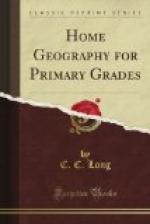[Illustration: “WE PASSED TOWNS AND CITIES.”]
“And now farewell, little squirrel. My story is done, and I must hasten to my home in the sea. Perhaps we shall meet again some day. I may float down to you, a white-winged snowflake, or patter down as I came this time, a tiny raindrop.”
Write the following:
The water rises from the sea in vapor.
The vapor is turned into clouds, which fall in rain or snow.
The rain forms rivers, which flow back again into the sea.
Thus the water is always going round and round in its long and curious journey—up to the clouds in vapor, down in rain, back in streams to the place it started from.
LESSON XXIII.
THE RIVER.
“Oh, tell me, pretty river,
Whence do thy waters flow?
And whither art thou roaming,
So smoothly and so slow?”
“My birthplace was the mountain,
My nurse the April showers;
My cradle was a fountain,
O’er-curtained by wild
flowers.
“One morn I ran away,
A madcap, noisy rill;
And many a prank that day
I played adown the hill!
“And then ’mid meadowy banks,
I flirted with the flowers,
That stooped with glowing lips
To woo me to their bowers.
“But these bright scenes are o’er,
And darkly flows my wave;
I hear the ocean’s roar—
And there must be my grave!”
Where have you seen a river like the one spoken of in the poem? Are rivers born? What is meant by “My nurse the April showers”? “I flirted with the flowers”? Explain the last stanza.
LESSON XXIV.
A MAP
A drawing made to show a room, or a house; or the school-yard, or even a village, is called a plan.
Drawings which represent land and water are called maps. You may learn from maps where the countries, and mountains, and rivers, and cities are that you have seen. It also shows how far places are from one another.
Here is a map showing mountains and rivers. The many short lines facing each other represent mountains. To show the very high part of the mountains, the lines are drawn close to each other, making that part of the map look dark. The line winding about, like the stream itself, represents a river. The line, as you see, is made thicker and thicker toward its mouth. From this you may know that the river itself becomes broader and broader as it flows toward the sea.
But you must not think that the crooked line on the map is a river, or the lines which face each other are mountains. If you do, you will learn very little of geography. When you look at these lines, you must think of the real things which they stand for—the lofty mountains, with their covering of forests, and with long, narrow valleys between them; the winding, gently flowing river, bearing boats upon its waters.




